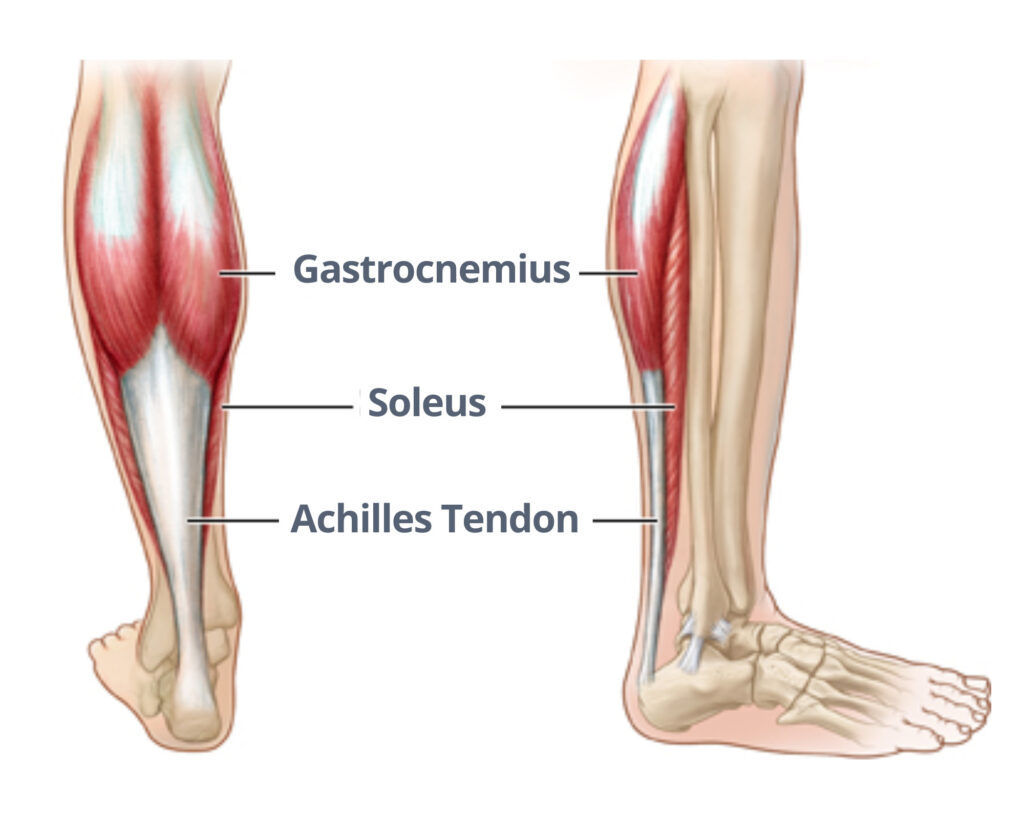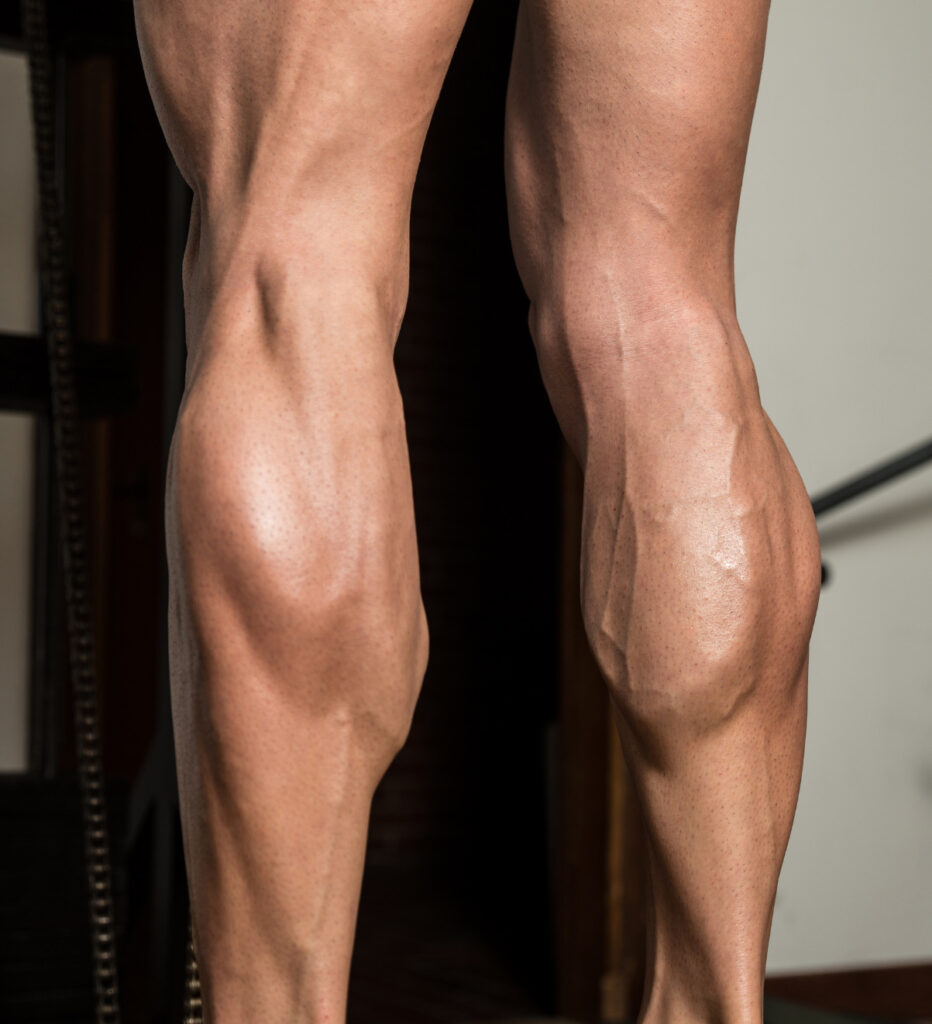
Why Do Runners Get Calf Strains?
Calf strains happen in runners for two main reasons. One is a single traumatic event, like missing a step on a kerb or jumping over an uneven part of a trail during an off-road run. The second situation, which is more common in middle-long distance runners, is when there is progressive overloading of the calf muscle so that eventually it just “goes” during a normal stride.
Either way, calf strains are an annoying injury that plague many runners. If they are not managed properly they can continue to be a niggly injury or can become recurrent, which can really disrupt your training and keep you off the road completely for a while. So preventing and managing calf strains is a top priority for middle-long distance runners.
What Muscles Make Up The Calf Muscle Complex?

The calf muscle complex is made up of two muscles: the gastrocnemius and the soleus.
The Gastrocnemius is a two joint muscle which crosses the knee and the ankle. Injuries typically occur during higher speed movements where the muscle is placed under high load when its lengthening.
The Soleus is a single joint muscle crossing the ankle. Injuries typically occur more due to overuse and an inability to recover from training demands.
Calf Loading During Running
Running places high demands on the calf complex regardless of running speed. During the early to mid-stance phase of running (i.e. when the foot is on the ground) the gastrocnemius and soleus can be loaded upwards of 1.9 and 6.7 times bodyweight respectively.
This relatively high load placed on the calf with each stride, when multiplied by thousands of strides during each run, then multiplied again by running several times each week/month/year, helps to explain why calf muscle strains are a common problem for runners. It also helps explain why strengthening the calf muscles is such an important part of reducing the risk of calf muscle strains, as well as managing strains should they occur.
Calf Strengthening Exercises – Great For Running Performance As Well As Injury Prevention And Management

While we are talking about calf muscle strains in this blog, it’s also worth noting that strengthening the calf muscles can really help your running performance. Increasing the strength, power and endurance of your calf muscles can help you get more power from each stride and reduce ground contact time. This means that you can run faster for longer with less chance of injury.
Types Of Calf Muscle Strains
As mentioned above, calf strains are either due to a one-off forceful contraction, or progressive overload of the calf muscle complex so that eventually even a relatively normal load can cause a strain. Common scenarios where calf strains occur include;
– A one-off forceful contraction, typically eccentric, whereby the capacity of the calf is acutely
overloaded
– Training changes with too rapid increase of intensity (speed, intervals) or volume (session load or session frequency)
– Reduced calf strength and endurance, for example after a previous calf injury where inadequate rehab has been performed. This can also be caused by an injury in another body part which required time out of sport. In this case the calf muscle becomes deconditioned even though it wasn’t involved in the original injury, but a calf strain occurs as you get back into training or competition.
– Total lower limb weakness (hip and knee)
– Technique changes which change load demands on different structures, for example changing to a forefoot strike running gait increases load placed on the calf muscle complex
– Footwear can be a factor by altering force on lower limb structures including the calf
– Terrain and running surface can also be a factor, for example hills, trails, grass, concrete, sand… Different angles and loads produced by running on sloping and/or uneven surfaces can overload the calf muscles
When Can You Run Again After A Calf Muscle Strain? Injury Diagnosis And Grading
Pretty much the big question on every runner’s mind when they come to see us for treatment of an injury is “When can I run again?“. Grading the severity of calf muscle strains helps guide initial treatment and subsequent rehab. Importantly, it helps give an idea of how much time may be required with reduced training loads or out of activity completely. We grade calf muscle strains on a scale of 1 – 3, with 3 being the biggest degree of injury.
GRADE 1:, Only a few muscle fibres damaged, no loss in strength or range of motion, no swelling or bruising. Typically takes 1-2 weeks to reintroduce some running.
Grade 2: Nearly half of the muscle fibres are torn, significant pain and tenderness, slight swelling, and loss of strength. Typically takes 2-6 weeks to reintroduce some running.
Grade 3: Complete rupture in either the muscle belly or between the muscle and the tendon, severe pain and swelling, bruising and complete loss in strength. Typically takes 12+ weeks to reintroduce some running.
Phases Of Calf Strain Management And Treatment
While the rehab program for any injury is unique for that person, there are some established guidelines that we use to manage calf strains in runners.
Phases 1: symptom management + maintain active range of motion. Start gentle loading as early as possible to promote tissue healing (this depends on grade of the strain and symptom response).
Phases 2: build strength and begin some light running. During this phase exercise selection
depends on tolerance whereby symptoms shouldn’t go beyond a 3 out of 10 pain and shouldn’t be
significantly worse next day.
Phase 3: progression back to full running and continued strengthening to protect against future injury.
Physio For Calf Strains And Running Injuries
If you have any questions about running injuries, including calf strains, then our physio team have all the answers that you need. Click below to send us a question or book online, or give us a call on 9280 2322.
References
Bramah, C., Preece, S. J., Gill, N., & Herrington, L. (2021). Kinematic characteristics of male runners
with a history of recurrent calf muscle strain injury. International Journal of Sports Physical Therapy,
16(3), 732.
Fields, K. B., & Rigby, M. D. (2016). Muscular calf injuries in runners. Current sports medicine reports,
15(5), 320-324.

